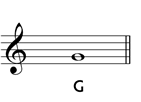Reading Music : Reading Musical Notes
Now that we know how to read rhythms, how do we then read musical notes?
Notes are written on a staff:

The clef assigns names to the notes. The following example shows a staff with a treble clef. The treble clef is commonly used for high-pitched instruments such as the flute and violin. This clef assigns the note G to the second line. Notice how the shape of the treble clef seems to wrap around the second line. All notes written on this line are G:

The note written on the space above G is an A. The one on the following line is a B. As you can see, the notes continue in order (A, B, C, D, E, F, and G), alternating lines and spaces:

Using ledger lines, we can write notes higher than the G and lower than the D:

To help memorizing notes on the staff, it is useful to memorize the names of the notes over the lines and spaces:

The notes over the spaces make the word FACE. The notes over the lines can be memorized using the following phrase: Every Good Boy Does Fine.
Practice note reading with our Clef Reading exercise.
Translated by Dan Román, revised by Sue Talley.
